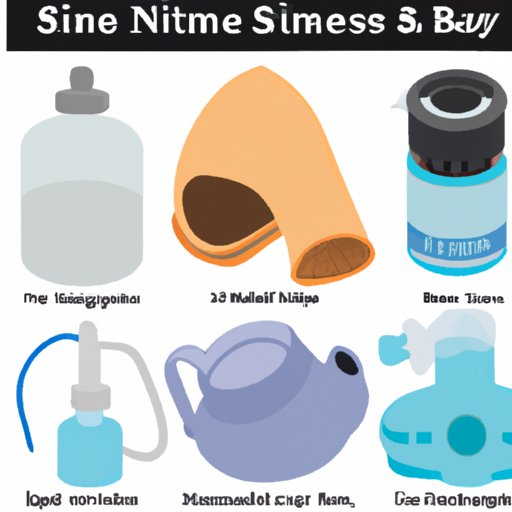Introduction
Sinus pressure is the feeling of tightness or fullness in the face that’s often accompanied by pain and/or discomfort. It’s caused by inflammation in the sinuses, which are the hollow cavities behind the nose, cheeks, and forehead. Sinus pressure can be the result of an infection, allergies, or other irritants.
Common symptoms of sinus pressure include headaches, facial tenderness, congestion, runny nose, sore throat, and coughing. In some cases, it can also cause bad breath and fatigue.
Steam Inhalation
Steam inhalation is one of the most effective ways to relieve sinus pressure. The heat and moisture from the steam help to reduce inflammation and open up the airways, making it easier to breathe. Plus, the steam can help loosen mucus buildup, allowing it to be cleared more easily.
Benefits of Steam Inhalation: Steam inhalation can help reduce inflammation, relieve congestion, and improve breathing. It can also help soothe sore throats and clear out mucus.
Tips for Proper Use: To get the most out of steam inhalation, make sure to use distilled or filtered water. Boil the water for about five minutes before inhaling the steam. Place a towel over your head to trap the steam, and keep your eyes closed to prevent irritation. Inhale the steam for 10-15 minutes, and repeat as necessary.
Use a Neti Pot
A neti pot is a small teapot-like device that’s used to flush out the nasal passages. It works by pouring a saline solution into one nostril while tilting your head sideways. This helps to flush out any mucus or debris that may be causing sinus pressure.
Benefits of Using a Neti Pot: Using a neti pot can help reduce inflammation, relieve congestion, and improve breathing. It can also help clear out mucus and reduce the risk of infections.
Tips for Proper Use: Before using a neti pot, make sure to use distilled or filtered water. Boil the water for at least five minutes, then let it cool down before use. When using the neti pot, tilt your head sideways and pour the saline solution into one nostril. Allow the solution to flow out of the other nostril. Repeat this process two or three times per day.
Apply Warm Compresses
Applying a warm compress to the face can also help to relieve sinus pressure. The heat helps to reduce inflammation and open up the airways, making it easier to breathe. Plus, the warmth can help soothe soreness and discomfort.
Benefits of Applying Warm Compresses: Applying a warm compress can help reduce inflammation, relieve congestion, and improve breathing. It can also help soothe soreness and reduce discomfort.
Tips for Proper Use: To get the most out of a warm compress, make sure to use a clean cloth. Soak the cloth in warm water and wring out the excess. Apply the cloth to the face for 10-15 minutes at a time. Repeat as necessary.
Avoid Allergens
Allergens can trigger an allergic reaction, which can lead to sinus pressure. Common allergens include dust mites, pet dander, mold, and pollen. To reduce the risk of an allergic reaction, it’s important to avoid these allergens as much as possible.
Tips for Avoiding Allergens: To reduce your exposure to allergens, make sure to keep your home clean and free of dust and debris. Vacuum regularly, and use an air purifier if possible. Also, try to stay indoors when the pollen count is high, and avoid going outside when it’s windy.
Drink Plenty of Fluids
Drinking plenty of fluids is essential for relieving sinus pressure. Staying hydrated helps to thin out mucus and reduce inflammation, making it easier to breathe. Plus, drinking fluids can help flush out toxins and impurities that may be causing congestion.
Benefits of Drinking Plenty of Fluids: Drinking plenty of fluids can help reduce inflammation, relieve congestion, and improve breathing. It can also help flush out toxins and impurities.
Tips for Increasing Fluid Intake: To stay hydrated, make sure to drink plenty of water throughout the day. You can also drink other fluids, such as herbal tea, fruit juice, and sports drinks. Avoid caffeine and alcohol, as they can actually dehydrate the body.
Try Saline Nasal Spray
Saline nasal spray is another effective way to relieve sinus pressure. The salt in the spray helps to reduce inflammation and open up the airways, making it easier to breathe. Plus, the spray can help loosen mucus buildup, allowing it to be cleared more easily.
Benefits of Using Saline Nasal Spray: Saline nasal spray can help reduce inflammation, relieve congestion, and improve breathing. It can also help loosen mucus and reduce the risk of infections.
Tips for Proper Use: When using saline nasal spray, make sure to follow the directions on the packaging. Start by blowing your nose, then tilt your head slightly and spray the solution into one nostril. Allow the solution to flow out of the other nostril. Repeat this process two or three times per day.
Conclusion
Sinus pressure can be uncomfortable and even painful. Fortunately, there are several ways to relieve sinus pressure, including steam inhalation, using a neti pot, applying warm compresses, avoiding allergens, drinking plenty of fluids, and using a saline nasal spray. By following these tips, you can help reduce inflammation and congestion, making it easier to breathe and reducing discomfort.
(Note: Is this article not meeting your expectations? Do you have knowledge or insights to share? Unlock new opportunities and expand your reach by joining our authors team. Click Registration to join us and share your expertise with our readers.)
